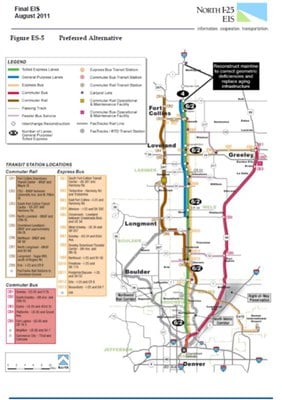North I-25 Commuter Rail Update
 The North I-25 EIS was completed in 2011. During the development of the preferred alternative there was an expectation that an “Eastern Bypass” for freight rail could be created, promising to divert through-trains from the populated areas between Fort Collins and Denver to the eastern plains of Colorado, and allowing more track capacity to become available for passenger use. Changes in the economy, changes in the partnering relationships, and other studies over the last few years have come to varying conclusions.
The North I-25 EIS was completed in 2011. During the development of the preferred alternative there was an expectation that an “Eastern Bypass” for freight rail could be created, promising to divert through-trains from the populated areas between Fort Collins and Denver to the eastern plains of Colorado, and allowing more track capacity to become available for passenger use. Changes in the economy, changes in the partnering relationships, and other studies over the last few years have come to varying conclusions.
Updating the assumptions for commuter rail in this corridor allows CDOT and local government partners to work from a common set of expectations for the commuter rail element of the North I-25 EIS. Further this effort is aligned with the State Rail Plan goal of maintaining Colorado’s readiness to pursue Federal funds should they become available. The commuter rail element of the EIS is shown as the brown line on the map, from Fort Collins through Longmont, and connecting to RTD’s North Metro line near 162nd Avenue & Colorado Boulevard.
The study is updating three main areas: (1) right-of-way, (2) operating plan, and (3) cost estimates. The EIS assumed that the existing single track configuration could be augmented with limited passing sidings and right-of-way implications. With freight service remaining on the corridor, combined with the operating plan discussed below and the knowledge learned from the RTD/BNSF negotiations on the Northwest Corridor (same BNSF line), the track configuration will require full double tracking with additional passing sidings, and expanded right-of-way needs. Correspondingly, the operating plan and commuter rail travel times will be updated.
The goal of the cost-estimating task is to update the right-of-way needs and to establish an appropriate cost for the US 287 / BNSF Railway corridor, inclusive of updating from 2009$ values of the FEIS to current 2014$. At the end of the process, the final updated cost estimate will be presented in “standard cost category” (SCC) format used by both the Federal Transit Administration (FTA) and Federal Railroad Administration (FRA).
